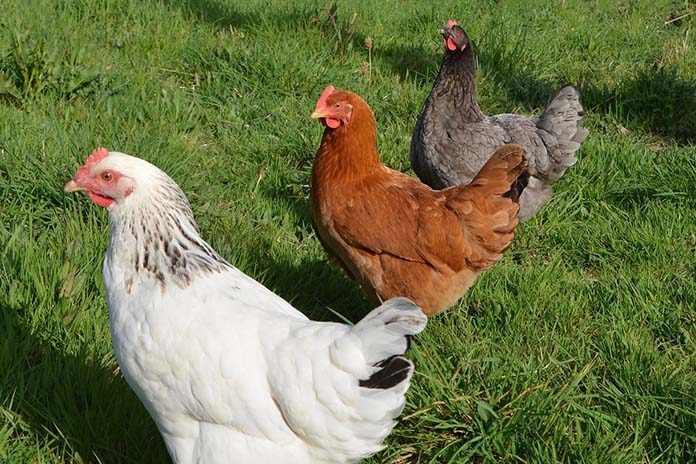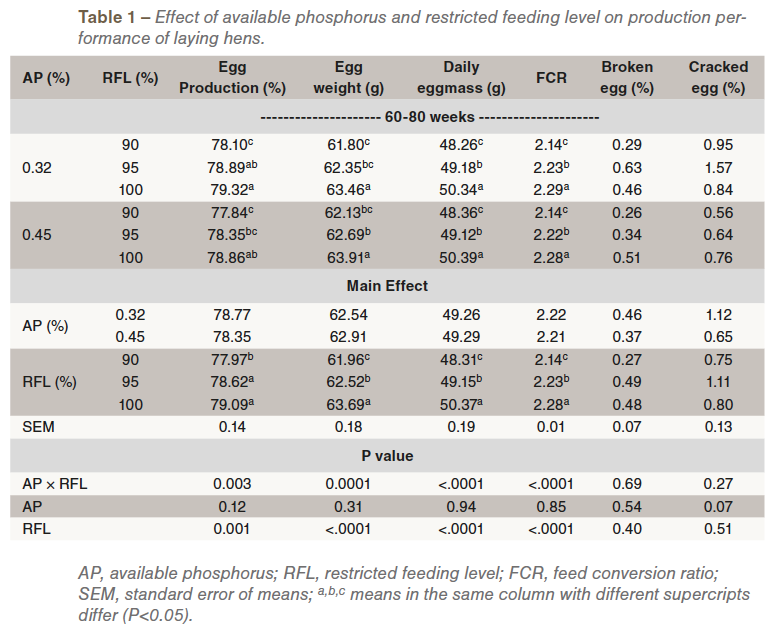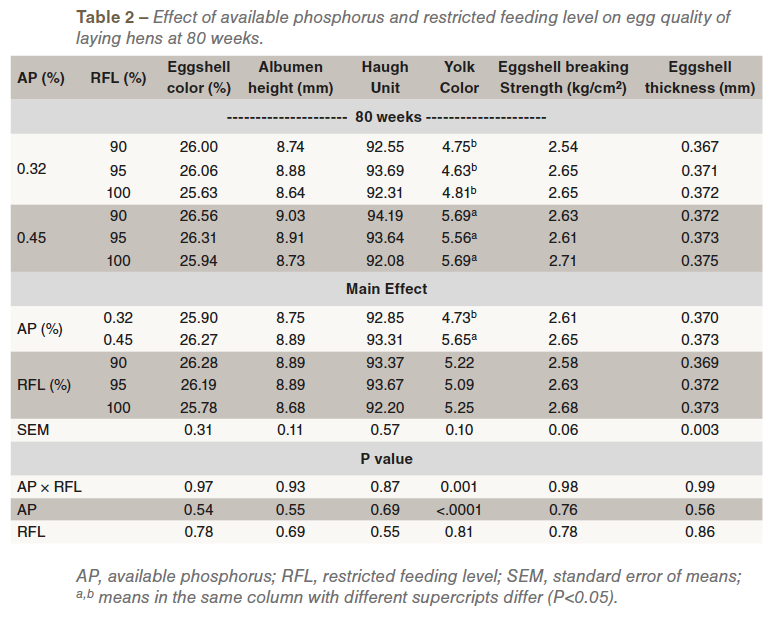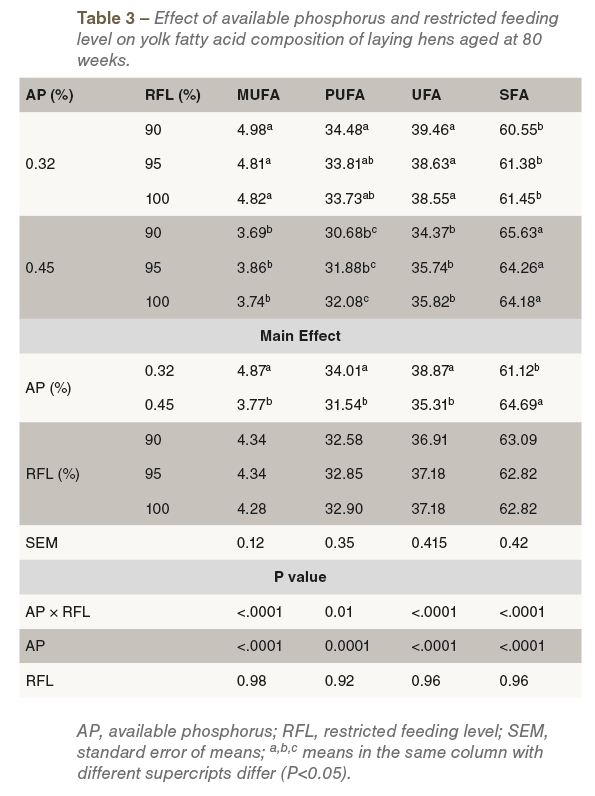
This study was performed to evaluate the effect of available phosphorus and restricted feeding level on laying hens productivity, egg quality and yolk fatty acids profile.
A total of 432 commercial laying hens which were 60 weeks old were assigned to six treatment groups each of four replications (two hens/cage) and feeding trial was conducted for twenty weeks. The trial was set up in a 2×3 factorial arrangement: two levels of AP (0.32 and 0.45%) and three feed restriction levels (90, 95 and 100%), with constant dietary ME 2,750 kcal/kg, CP 15% and Ca 4.5%. The results showed that egg production, egg weight, daily egg mass and feed conversion ratio were highly significant (P<0.01) among the treatments and the restricted feeding levels. However, production parameters were not influenced by dietary AP levels. The egg production rate was significantly (P<0.01) affected by increasing the feed restriction but statistically similar mean noticed between 90 and 100% feeding. In addition, egg weight, daily egg mass and feed conversion were reduced linearly (P<0.01) by increasing levels of feed restriction.
There was no difference found in broken and cracked eggs among the dietary groups and the main effects of AP, and RFL. Egg quality didn’t differ among all treatment groups except yolk color. Significantly higher yolk color (P<0.01) was obtained at 0.45% AP level. Furthermore, higher concentration of monounsaturated fatty acids (MUFA), polyunsaturated fatty acids (PUFA), unsaturated fatty acids (UFA) and lower saturated fatty acids (SFA) were found in the main effect of 0.32% AP (P<0.01). Based on the results of the present study, quantitative feed restriction levels 95% and 0.32% AP in diet may be efficient on the basis of hen day egg production and egg quality at older laying period.
Introduction
Cost of production is consisted to be a crucial factor in raising commercial poultry under intensive management system. Feed is the largest single item of expenditure of poultry production and accounting for more than two-thirds of the total cost of production. In addition, the cost of per kilogram feed is increasing day after day and other poultry utensils without any proportionate increase in the price of eggs.
So that, it is a major challenge to optimize production performance of laying hens while reducing dietary cost. As a result, the quest to reduce dietary cost and improve profitability has resulted in the development of various strategies like limiting the intake of specific nutritional factors as energy or amino acids and regulating the consumption of a balanced diet. Thus, quantitative feed restriction is one of the possible ways to control body weight of hens during laying period and metabolic rate to some extent as well as improving feed conversion and reducing feed cost.
On the other hand, the restriction has also been accompanied by a decrease egg production, egg weight, egg mass, or one or more of these in most cases, though it depends on the strain of bird and the level of restriction. In previous study, observed that significant effect of feed restriction on egg production rate in Hisex Brown layer strain. The researchers however, reported that egg weight and egg quality traits were not affected by the dietary restriction. In contrast, other researchers speculated that feed deprivation has no significant effect on egg production rate, egg weight and egg quality.
Phosphorus is one of the key nutrient not only involved for egg production and eggshell quality of laying hens but also regulate various metabolic process in the body. Dietary available phosphorus either high or low in laying hens diet may adversely affect the bird’s performance and reduce the eggshell quality.
According to Boorman and Gunaratne, in 2001, reported dietary phosphorus requirement of hens are uncertain and vary from 2.0 to 3.5 g of available phosphorus per kilogram of diet. Pelicia et al., in 2009, did not find any effect on production performance and eggshell quality when dietary level of available phosphorus was 2.5 to 4.0 g/kg and concluded that around 3.0g/kg AP was sufficient for brown egg layers.
However, eggs with inferior shell quality to be an important problem generally it occur in aged laying period and leads economical loss to poultry producers. Meyer and Parsons, in 2011, who stated that inadequate phosphorus supply in hens diet decrease in eggshell breaking strength that indicate thinner eggshell.
However, adequate phosphorus requirement of laying hens have been challenged in the recent years due to the continuous advances in genetic improvement, nutrition, environment, management and uncertain content of phosphorus in cereal grains.
In addition, there is no available literature about the phosphorus requirement of hens at the finishing cycle.
Therefore, objective of this study was to assess the levels of feed restriction and available phosphorus on production performance, egg quality and yolk fatty acid composition from 60 to 80 weeks of age.
Material and methods
Four hundred and thirty two of aged commercial layer strain were used and kept in metabolic cages (A-type three-deck reverse cage). Hens were distributed in a completely randomized design with a 2×3 factorial arrangement, two levels of available phosphorus (AP, 0.32, 0.45%) and three restricted feeding levels (RFL, 90, 95 and 100%). Each treatment consisted of four replicates having 18 hens each and two hens at a time put into one wire cage. Birds were subjected to 7 days adaptation period and offered mash feed according to the breeders manual (115 g/hen/day). The experiment was carried out a total of 20 week period (60 to 80 weeks of age). Throughout the experimental period, a room temperature of 25 °C ± 5 °C and a photoperiod of 16/8 hours light/dark were maintained.
All mortality was replaced by spare hens kept up on identical treatments. The basal diet contained 2,750 kcal/kg of ME, 15% CP, 4.30% Ca, 0.32% AP and aminoacid (0.31% Met and 0.75% Lys). According to the treatment, experimental diets were prepared with an AP content of 0.32 or 0.45% and the calcium content was maintained constant at 4.5%. Adjustment of Ca and AP was made by using limestone that contained 38.5% Ca and the primary source of phosphorus was mono-dicalcium phosphate (MDCP) which it comprised of 18% Ca and 21% P.
Egg production, broken and cracked eggs in each treatment were recorded daily, egg weight was taken every two days interval. Feed conversion ratio (FCR) was expressed as the ratio of gram of feed consumed per gram of egg weight. Egg mass was calculated by (% of egg production × average egg weight/100).
In the course of trial, a random sample of 16 eggs from each treatment (four eggs per replicate) were collected at every four weeks to measure egg quality such as egg shell color, shell thickness, shell breaking strength, albumen height, haugh unit and yolk color. At the termination of the experiment, eight eggs from each group were collected randomly in order to determine their fatty acids composition of yolk using gas chromatography (Agilent Technologies, Palo Alto, CA, USA).
Data were analyzed by ANOVA using the GLM procedure of SAS software (Version 9.1, 2002). Significant differences among variables were separated using the Duncan’s multiple range test with a p<0.05 was considered significant.
Results and Discussion
 The production performance with varying levels of feed restriction and available phosphorus in aged laying hens throughout the entire experimental period is presented in Table 1. There were significant effects of dietary interaction between access of feeding and available phosphorus levels on mean of egg production percentage, egg weight, egg mass and feed conversion ratio (FCR).
The production performance with varying levels of feed restriction and available phosphorus in aged laying hens throughout the entire experimental period is presented in Table 1. There were significant effects of dietary interaction between access of feeding and available phosphorus levels on mean of egg production percentage, egg weight, egg mass and feed conversion ratio (FCR).
In among the treatments, hens fed diet containing 0.32 or 0.45% AP with access of feeding 95 and 100% had showed statistically similar mean value of egg production rate. In the main effect of dietary AP levels over the 20 weeks period did not significantly effect on performance parameters. Similar findings as to AP levels were obtained by Park et al., in 2009, who reported that 0.30 or 0.40% AP in diets of aged laying hens had no effect on hen day production, egg weight, feed intake and feed conversion ratio.
They suggested that production performance of laying hens was better when 0.30% AP in diet which was in accordance with present study. In another study, Meyer and Parsons, in 2011, also stated that hens fed diet containing 0.20 or 0.105% AP supplemented with 150, 250, or 15,000 FTU/kg of phytase was not significant different from that of hens fed diet containing 0.45% AP.
Egg production percentage had varied among the sole impact of RFL but 95 and 100% access of feeding did show statistically similar mean value. Reduction in egg production percentage with increasing severity of feed restriction observed in this study was in line with report of Simeon Olutoye Olawumi in 2014, but who proposed that milder quantitative feed restriction is in keeping with optimal production performance of hens after 40 or more weeks. According to Moreira et al. (2012) reported that significant reduction in laying percentage promoted when hens subjected to feed restriction 8% or more of hens fed ad-libitum.
In addition, there were significant differences in egg weight, daily egg mass and feed conversion ratio, and mean values of these parameters were linearly reduced with increasing level of feed limitation. These discrepancies may be attributed due to the imposition of restricted feed, there might be limited the daily energy, calcium and phosphorus intake of laying hens. No difference was observed in broken and cracked eggs percentage among the treatments and in the effect of AP and the RFL. As for dietary AP in diet from 0.25 to 0.40%, Pelicia et al. (2009) did not observe any effect on broken and defective eggs during entire the study.
The effect of dietary AP and restricted feeding levels on the quality of produced eggs is presented in Table 2. As shown, yolk color significantly affected among the treatment groups and in the sole effect of AP levels, whereas other quality characteristics (egg shell color, albumen height, eggshell strength and eggshell thickness) were unaffected in RFL or AP levels and in their interaction. The yolk color of the eggs from the hens fed diet containing 0.45% AP with restricted feeding level was significantly higher (P<0.01) but showed statistically same mean than that of 0.32% AP with RFL. In addition, hens fed on the diet containing AP of 0.45% produced eggs significantly higher yolk color than fed on diet with lower AP (0.32%). A possible reason for yolk color, higher AP level in diet may be increased blood phosphorus concentration through the metabolic process, resulting in more intense yolk color observed in the present study. As well as albumen height, haugh unit, shell strength and shell thickness were positively influenced by increasing dietary phosphorus. The result in the present study are in corroboration with those reported by Park et al. (2009) who found that egg quality parameters were improved in aged laying hen when dietary levels of nonphytate phosphosrus (or AP) were 0.30 to 0.40%. Concomitant to the findings of the present study, Nie et al. (2013) reported that all egg quality parameters had positively enhanced when 0.05% increment of nonphytate phosphorus from 0.20 to 0.40% in laying hens diet. The egg quality parameters in the present study were not affected by feed restriction. It is in keeping with the report of Moreira et al. (2012) who reported egg quality characteristics were not altered by the restriction levels of feeding in laying hens.

There were significant effects of dietary interaction between AP and RFL on yolk fatty acids throughout the experimental period (Table 3). Total monounsaturated fatty acids (MUFA), polyunsaturated fatty acids (PUFA), and unsaturated fatty acids (UFA) were occurred significantly higher while saturated fatty acids (SFA) was lower when hens fed diet containing 32g/kg AP with feed restriction levels as that of 45g/kg with feed restriction levels. As the effect of AP, the highest value of MUFA, PUFA and UFA were found in 0.32% AP content diet whereas SFA was decreased. Nevertheless, there were no differences noticed among the fatty acids content in eggs of the hens fed with quantitative feed restriction and full-fed control.
However, it is well documented that inclusion of rapeseed, flaxseed, canola seed, sunflower oil and diets containing different levels of conjugated linoleic acid and fish oil in layer hens diet have a positive effect on egg fatty composition, though difference results of the current study, it is not comparable with the previous findings, in that case, relevant literature did not find how dietary interaction of AP with restriction feed and the effect of AP levels had contributed to the difference in egg yolk fatty acid.

Conclusion
From the present study, it can be concluded that hens subjected to 5% feed restriction and dietary inorganic phosphorus at the level of 0.32% was enough for optimum egg production rate and egg weight. In addition, hens fed on diet containing 0.32% AP improved yolk fatty acids profile from 60 to 80 weeks.
References are available on request
From the Proceedings of the 6th Mediterranean Poultry Summit, 2018

















